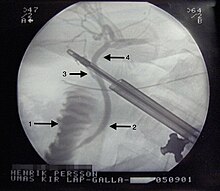Laparoscopic cholecystectomy
| Cholecystectomy | |
|---|---|

Cholangiogram (X-Ray) during Laparoscopic Cholecystectomy. 1 - Duodenum. 2 - Common bile duct. 3 - Cystic duct. 4 - Hepatic duct. The gallbladder is not seen as the cystic duct is occluded by the surgeon.
|
|
| ICD-9-CM | 575.0 |
| MeSH | D002763 |
Cholecystectomy (/ˌkɒləsɪsˈtɛktəmi/; plural: cholecystectomies) is the surgical removal of the gallbladder. It is a common treatment of symptomatic gallstones and other gallbladder conditions. Surgical options include the standard procedure, called laparoscopic cholecystectomy, and an older, more invasive procedure, called open cholecystectomy. The surgery can lead to postcholecystectomy syndrome, as well as more serious complications such as bile duct injury.
Indications for cholecystectomy include inflammation of the gall bladder (cholecystitis), biliary colic, risk factors for gall bladder cancer, and pancreatitis caused by gall stones.
Cholecystectomy is the recommended treatment the first time a person is admitted to hospital for cholecystitis. Cholecystitis may be acute or chronic, and may or may not involve the presence of gall stones. Risk factors for gall bladder cancer include a "porcelain gallbladder," or calcium deposits in the wall of the gall bladder, and an abnormal pancreatic duct.
Cholecystectomy can prevent the relapse of pancreatitis that is caused by gall stones that block the common bile duct.
...
Wikipedia
